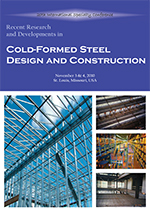Session Dates
03 Nov 2010
Abstract
The objectives of this paper are to expl ore (a) how corners of cold-formed steel members are included or ignored in current design methods, and (b) the effectiveness of recent proposals for modifying the strength prediction for local buckling to account for corners. The imp act of round corners is examined on the behavior and strength of isolated elements and on full members using material and geometric nonlinear collapse analysis with shell finite elements in ABAQUS. Comparisons between the available methods and the nonlinear finite element analysis are completed to explore the regimes in which the methods are accurate, as well as when they are deficient. The current appr oach in the main Specification of AISI-S100-07, which applies no reductions regardless of corner size, is demonstrated to be uncons ervative. Initial recommendations for the design of sections with large corner radi us by effective width and direct strength methods are provided.
Department(s)
Civil, Architectural and Environmental Engineering
Research Center/Lab(s)
Wei-Wen Yu Center for Cold-Formed Steel Structures
Meeting Name
20th International Specialty Conference on Cold-Formed Steel Structures
Publisher
Missouri University of Science and Technology
Document Version
Final Version
Rights
© 2010 Missouri University of Science and Technology, All rights reserved.
Document Type
Article - Conference proceedings
File Type
text
Language
English
Recommended Citation
Zeinoddini, V. and Schafer, B. W., "Impact of Corner Radius on Cold-formed Steel Member Strength" (2010). CCFSS Proceedings of International Specialty Conference on Cold-Formed Steel Structures (1971 - 2018). 1.
https://scholarsmine.mst.edu/isccss/20iccfss/20iccfss-session1/1
Impact of Corner Radius on Cold-formed Steel Member Strength
The objectives of this paper are to expl ore (a) how corners of cold-formed steel members are included or ignored in current design methods, and (b) the effectiveness of recent proposals for modifying the strength prediction for local buckling to account for corners. The imp act of round corners is examined on the behavior and strength of isolated elements and on full members using material and geometric nonlinear collapse analysis with shell finite elements in ABAQUS. Comparisons between the available methods and the nonlinear finite element analysis are completed to explore the regimes in which the methods are accurate, as well as when they are deficient. The current appr oach in the main Specification of AISI-S100-07, which applies no reductions regardless of corner size, is demonstrated to be uncons ervative. Initial recommendations for the design of sections with large corner radi us by effective width and direct strength methods are provided.



